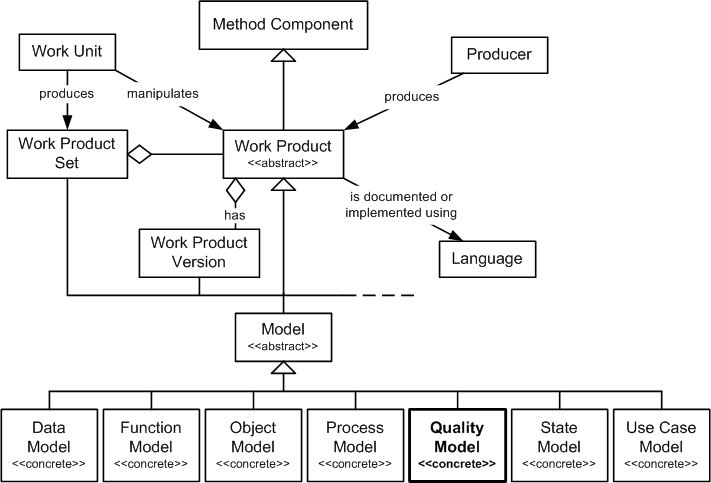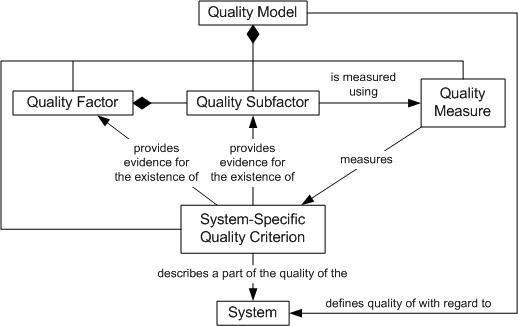Quality Model
- Quality Model
- a model work product
that formalizes the definition of the term
“quality” as used during an
endeavor.
As illustrated in the preceding figure, Quality Model is part of the following inheritance hierarchy:
The typical responsibilities of a quality model are to:
- Define, analyze, and document an endeavor’s quality factors, quality subfactors, and quality measures.
- Increase the quality of the associated business enterprise, system, application, or component.
- Enable the:
- Elicitation, reuse, analysis, and specification of quality requirements.
- Production of associated architectural mechanisms for
meeting the associated quality requirements.
- Production of testing work products for testing the
implementation of these quality requirements and architectural mechanisms.
The typical contents of a quality model include:
- Quality Factors
(a.k.a., Quality Attributes, Quality Characteristics, “ilities”)
- Important attributes, characteristics, or properties of a
work product (e.g., application, component, model, or document)
or process that characterize a part of its overall quality
- Quality Subfactors
- Important parts of
quality factors
or other quality subfactors
- Quality Criteria
- Specific descriptions of something that provides
evidence either for or against the existence of a specific
quality factor or subfactor
- Quality Measures
- Measures that provide numerical values estimating the quality of a work product or
process by measuring the degree to which the work product or process possess a specific quality factor
The relationship beween the components of the quality model
and related items is illustrated by the following:
The typical stakeholders of a quality model are:
- Producers:
- Quality Team,
which produces the quality factors and the quality metrics part of the quality model.
- Requirements Team,
which produces the quality goals and quality requirements part of the quality model.
- Evaluator:
- Approvers:
- Maintainers:
- Users:
- Quality Team,
which documents the quality model in the quality plan.
- Requirements Team,
which uses the quality model to analyze quality requirements and specify them in the
system requirements specification.
A quality model is typically developed during the following phases:
A quality model can typically be started if the following preconditions hold:
- The quality team
is adequately staffed and trained in quality engineering.
- The requirements team
is adequately staffed and trained in requirements engineering.
The typical inputs to a quality model include:
- Work Products:
- Stakeholders:
- The contents of the quality model are documented in the
quality plan.
- This is a living model that is developed incrementally
and iteratively in parallel with other work products (e.g.,
quality plan,
application vision statement, and
system requirements specification).
- The quality factors drive the quality goals, which drive
the quality requirements, which drive the quality
architectural mechanisms, which drive the quality tests.
A quality model is typically constrained by the following conventions:
- Work Flow
- Content and Format Standard
- MS Word Template
- XML Template
- Inspection Checklist


